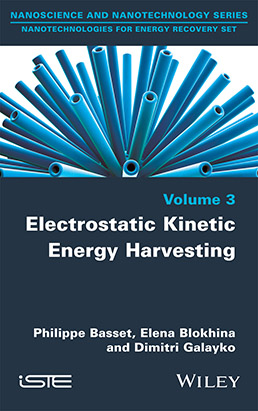
As we enter the age of the Internet of Things (IoT), miniaturization and efficiency are going to be predominant trends in microelectronics. Since the technologies of the future inevitably need energy sources, energy harvesting will continue to develop into an extremely active, versatile and growing area that attracts engineers and scientists from the field of electronics, microsystems and materials science. This book discusses electrostatic kinetic energy harvesting, which, in the opinion of the authors, is under-represented in the literature despite its particular compatibility to microtechnological applications.
While the primary focus of this book is energy harvesting employing the electrostatic transduction, it does cover all aspects necessary to understand and design an efficient harvester, including linear and nonlinear resonators, electrostatic transaction principles, microfabrication processes and the design of conditioning electronics.
Chapters 1, 2 and 7 discuss a capacitive energy harvester as a system, with additional chapters devoted to the operation in both the electrical and the mechanical domains. Chapters 3 through 6 discuss mechanical aspects of harvesters, and Chapters 8 through 11 are devoted to electronic conditioning circuitry. The authors have made a choice to present the material at a relatively high level of abstraction, limiting the discussion to the aspects that have most impact on the global operation of the harvester, while still providing the reader with a thorough understanding of the role and function of each component in an energy harvester.
1. Introduction to Electrostatic Kinetic Energy Harvesting.
2. Capacitive Transducers.
3. Mechanical Aspects of Kinetic Energy Harvesters: Linear Resonators.
4. Mechanical Aspects of Kinetic Energy Harvesters: Nonlinear Resonators.
5. Fundamental Effects of Nonlinearity.
6. Nonlinear Resonance and its Application to Electrostatic Kinetic Energy Harvesters.
7. MEMS Device Engineering for e-KEH.
8. Basic Conditioning Circuits for Capacitive Kinetic Energy Harvesters.
9. Circuits Implementing Triangular QV Cycles.
10. Circuits Implementing Rectangular QV Cycles, Part I.
11. Circuits Implementing Rectangular QV Cycles, Part II.
Philippe Basset is Associate Professor at University Paris-Est, France. He is an expert in the fields of microelectromechanical systems (MEMS), electrical engineering, electronic engineering and engineering physics.
Elena Blokhina is a lecturer at University College Dublin, Ireland. Her expertise lies in the area of nonlinear circuits and systems, oscillation theory and mathematical modeling.
Dimitri Galayko is Associate Professor at the UPMC-Sorbonne Universities in Paris, France. He is an expert in the field of microelectronics and in the field of integrated system design and modeling